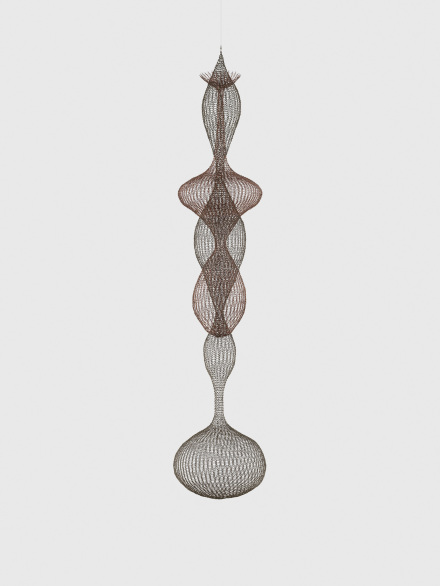
Ruth Asawa, Untitled (S.237, Hanging Six-Lobed, Interlocking Continuous Form), c. 1958, Private Collection © 2021 Ruth Asawa Lanier, Inc. / Artists Rights Society (ARS), New York. Courtesy David Zwirner
Marking an ambitious exploration of the life and work of artist Ruth Asawa, David Zwirner in New York is currently presenting All Is Possible, an expansive exhibition curated by Helen Molesworth that situates the artist’s iconic looped- and tied-wire sculptures in the context of her extraordinary drawings and her lesser-known sculptural forms. Presenting viewers with one of the most comprehensive looks at this artist’s work to date, the show larger context illuminates an artist in pursuit of form as a means to reshape the act of seeing, and the role of art in daily life.
The show focuses in particular on Asawa’s unification of both her conceptual exercises and the produced forms, exhibiting a range of drawings and prints that the artist produced, often in conjunction with her more well-recognized wire sculptures. Repetitive and meditative in nature, Asawa moved effortlessly between abstract and figurative registers in both two and three dimensions, creating a vast and varied oeuvre that, despite its visual heterogeneity, reflects above all her belief in the total integration of artistic practice and family life. These works appear throughout the show, underscoring her interest in motifs that move across forms and media, with Asawa using her interest in shared concepts to create a nuanced body of diverse works.
The show also presents a series of the artist’s iconic looped-wire sculptures, often made while sitting at her kitchen table or looking after her children—in a range of scales and formats. These wire assemblages, executed in complex, twisting arrangements and loping, lyrical movements through space, underscore a practice that Asawa seems to fit into a broader life context, underscore by works shown like her lesser-known drawings of the minutiae of everyday life—sleeping children, garden plants, and cane and wicker chairs—as well as the ceramic masks of her friends and many visitors to her home, which she would habitually cast in plaster, provide an intimate glimpse into the day to day. Placed in dialogue with the voluminous tied-wire sculptures she devised in 1962, frustrated by her attempts to draw in two dimensions a desert plant whose branches split exponentially, these works illuminate Asawa’s near-constant devotion to her creative pursuits and distinct way of seeing the world around her.
Marking an engagement with the artist’s work as an expansive exploration of her work as embedded in her daily life, the show makes for a striking exploration of Asawa’s practice in an expanded mode of living and creating.
The show closes December 18th.
– D. Creahan
Read more:
Ruth Asawa: All is Possible [Exhibition Site]



